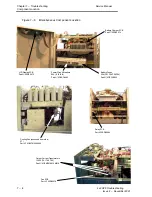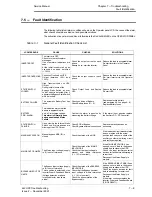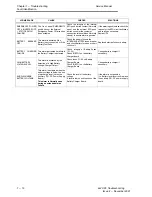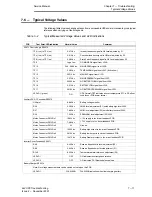
Service Manual
Chapter 6 - Maintenance
Battery Maintenance
6 - 6
UPS Maintenance
Issue 2 - November 2001
6.2 - Battery Maintenance
The batteries fitted within the UPS are valve regulated and require very little maintenance.
It is wrong to describe them as completely `maintenance free', because the batteries still require a mainĆ
tenance check, but at a significantly greater interval than the unsealed type.
The removal of the need to continually top up batteries, is a major advantage, but by removing access,
a visual examination of the cell plates, and electrolyte is impossible.
Battery condition and capacity can therefore only be determined as a complete 12V battery block.
The battery is an important component in the UPS system, as the UPS function relies on the battery
power, on failure of the input AC supply To ensure that the battery will support the UPS operation it should
be checked annually for performance.
6.2.1 - Factors Effecting Battery Use
The following factors affect the overall operation and ultimately the useful life of the UPS battery. These
considerations must be taken into account when deciding the serviceability of a battery.
Service life
Temperature is the major factor in determining the effective life of a battery if the battery is operating
above 200 C it will reduce the battery life. It is also important that the charge voltage is within limits. TypiĆ
cally a 5 year life battery will start to decline after 3 years in service, therefore the need for regular checks
is important.
Charge voltage
The nominal charge voltage is normally 2.25 volts per cell, multiplied by the number of cells in series.
Operation at voltages below 2.2 volts per cell, will lead to a undercharge and sulphation. Operation at
2.3 volts per cell and above, will cause overcharge and rapid positive plate corrosion. Positive plate corĆ
rosion is known to be the major life limiting component in all batteries, therefore for optimum life, battery
cell voltages must be within the range of 2.25 to 2.3 volts per cell.
The UPS has 32 x 12V batteries and is designed to operate with a float charge voltage of 432 V
DC.
Battery capacity
Battery capacity is used to define endĆofĆlife of the battery for example if the battery cannot supply 80%
it is deemed to be at the end of its effective life. For some applications 80% may be decreased to 50%
to mark the end of the batteries effective life.
Battery capacity from manufacture, usually increases slightly after 2 or 3 discharges and will be enĆ
hanced by high temperature and reduced by low temperature.
As the battery ages beyond 12 months the battery capacity will fall at a rate determined by the operating
temperature and the charge voltage. These adverse factors, will cause accelerate erosion to the positive
plate grid, reducing the effective battery capacity The life of the battery will then depend on the requireĆ
ments of the system, if the capacity of the UPS has been oversized then the load may only need 50%
of the normal duty.
In most applications, the battery is essentially on continuous float charge, and rarely will experience a
input supply failure longer than the end of the battery autonomy.
Therefore a battery in poor condition may well continue to support the load for short autonomies, but
will fail if the loss of the input AC supply exceeds 30 seconds.
It is therefore highly recommended that a battery autonomy test, is carried out as part of a regular mainĆ
tenance program.
Open circuit voltages
Measurement of the battery open circuit voltage is not a good indicator of the available capacity of the
battery It may apply to batteries on the shelf but not to batteries that have been on charge, up to 72 hours
prior to measurement. The terminal voltage of batteries that have been on charge, have an actual cell
voltage, plus a polarization voltage.
















































